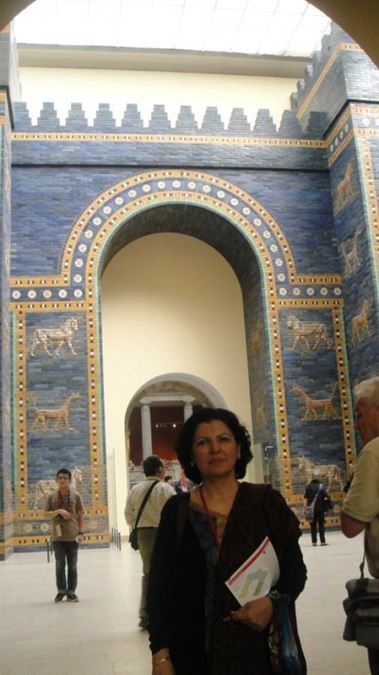The next day started with a journey on the underground to Alexanderplatz station.
Another tip I would like to give visitors is to take into account the power points in Europe. They use the round pin plugs and not flat ones. In the middle east we use flat pin and that meant I could not charge my mobiles for 2 days. Sunday every shop is closed. So on Monday Morning i headed straight to Saturn an electronics chain and bought myself an adapter.
The next thing on the agenda was to walk across to Park Inn and hop on the yellow bus. It being a Monday Saif had some work to do and so I decided to spend the time on Museum Island.
The first stop of course was Pergamon Museum. The site was designed by Alfred Messel and Ludwig Hoffmann and was constructed in twenty years, from 1910 to 1930. The Pergamon houses original-sized, reconstructed monumental buildings such as the Pergamon Altar and the Market Gate of Miletus, all consisting of parts transported from Turkey. The Pergamon Museum was severely damaged during the air attack on Berlin at the end of the Second World War. Many of the display objects were stored in safe places, and some of the large pieces were walled in for protection. In 1945, the Red Army collected all of the loose museum items, and it wasn;t until 1958 that most of the objects returned to East Germany. Significant parts of the collection remain in Russia.
I had heard about the Pergamon altar bur nothing had prepared me for the scale of it! it has to be seen to be believed.
with my ordinary camera there was no way I could do justice to it but whatever I could capture reinforces my memory.
There was a sense of peace in the room, even with so many people trying to get the best camera position or just sit on the steps and soak in the atmosphere
The Altar was built during the reign of King Eumenes II in the first half of the 2nd century BC on one of the terraces of the acropolis of the ancient city of Pergamon in Asia Minor.
The structure is 35.64 meters wide and 33.4 meters deep; the front stairway alone is almost 20 meters wide. The base is decorated with a frieze in high relief showing the battle between the Giants and the Olympian gods
A model of the actual altar.
There are so many treasures in the museum and it isn’t within my scope to post more than the two highlights of the museum and a few pieces which caught my eye.
The Ishtar Gate was the eighth gate to the inner city of Babylon. It was constructed in about 575 BC by order of King Nebuchadnezzar II on the north side of the city.
Dedicated to the Babylonian goddess Ishtar, the gate was constructed using glazed brick with alternating rows of bas-relief mušḫuššu (dragons) and aurochs.Originally the gate, being part of the Walls of Babylon, was considered one of the Seven Wonders of the world until, in the 6th century AD, it was replaced by the Lighthouse of Alexandria.
A reconstruction of the Ishtar Gate and Processional Way was built at the Pergamon Museum in Berlin out of material excavated by Robert Koldewey and finished in the 1930s
It was a double gate; the part that is shown in the Pergamon Museum today is the smaller, frontal part. The larger, back part was considered too large to fit into the constraints of the structure of the museum; it is in storage.
Every time I go to a museum in the west I feel i am in one of the world’s largest chor-bazaars!!!!
The size of the gate can be seen from the size of the people in front of it. Its cobalt and gold colors are just as vibrant today and I can appreciate its awe inspiring effect on visitors to the market in 575 BC…
The Mshatta Facade
This is the decorated part of the facade of the 8th century Umayyad residential palace of Qasr Mshatta, one of the Desert Castles in Jordan,
The facade was a gift from the Ottoman Sultan Abdul Hamid II to Emperor Wilhelm II of Germany, who had heard of its beauty.
It’s an important monument of early Islamic art and architecture, demonstrating early forms of the arabesque and also animals carved in relief.
This wall ran around the mosque and hence no animals just flowers
Some more exhibits from the museum:
Pitcher Perfect
The Aleppo Room is a reception room from a broker’s home in Aleppo, Syria that was commissioned during the Ottoman Period
dhoondho dhoondho re saajnaa more kaan ka baala
Literally an arms lenghth ( measurement standards on stone)
We decided to take advantage of the glorious sunshine and take a cruise along the River Spree.
You can take the cruise from Museum Island
Berlin is such a lovely welcoming place. The people are friendly and the transport system great.
There is so much to see and so much to do.

